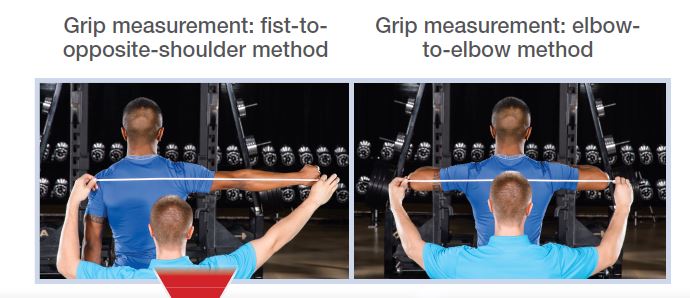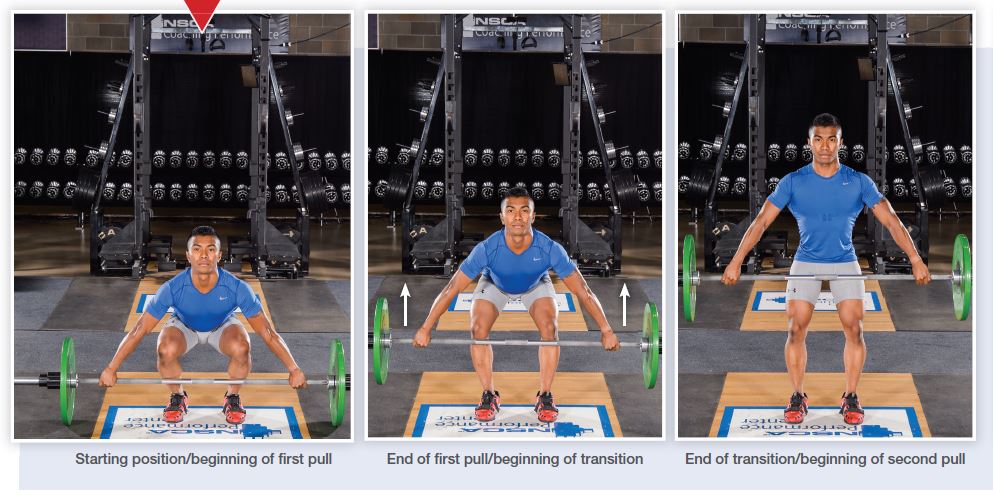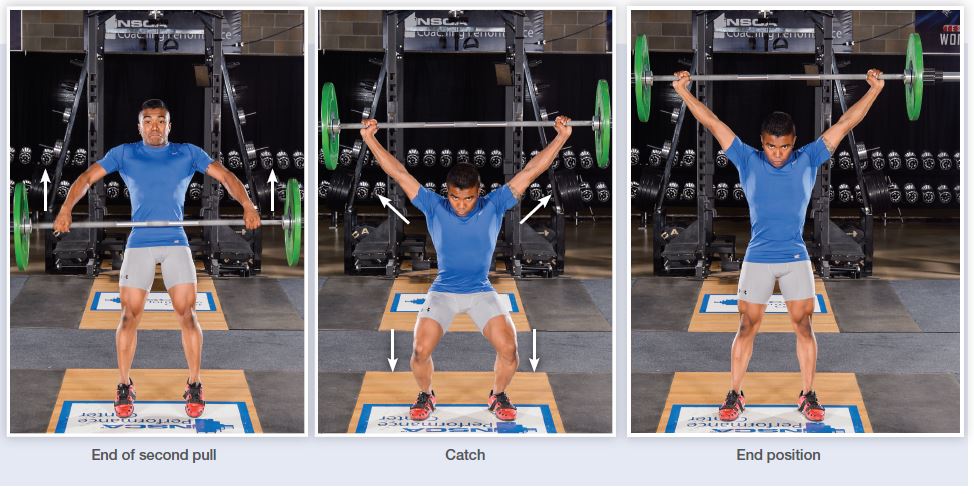Power Snatch
by Exercise Technique Manual for Resistance Training, 3rd Edition With Online Video
Kinetic Select
May 2017
This book excerpt provides a step-by-step breakdown of the movements of the power snatch, from the starting position to the downward movement.
The following is an exclusive excerpt from the book Exercise Technique Manual for Resistance Training-3rd Edition With Online Video, published by Human Kinetics. All text and images provided by Human Kinetics.
From the starting position, this exercise involves lifting the bar the upward movement consists of four distinct phases, the upward movement of the bar occurs in one continuous motion.
Starting Position
- Stand with the feet placed between hip- and shoulder-width apart with the toes pointed slightly outward so the knees track directly over the feet.
- Squat down with the hips lower than the shoulders and grasp the bar evenly with a pronated grip. The hand placement on the bar is wider than it is for other exercises. It can be estimated by measuring the distance from the knuckles’ edge of a clenched fist of an arm extended out to the side and parallel to the floor, across the back of the arm and upper back, to the outside edge of the opposite shoulder. Alternatively, the lifter’s grip width can be estimated by measuring the elbow-to-elbow distance when the upper arms are abducted directly out from the sides and parallel to the floor. This distance is the space between the hands when they are grasping the bar. If necessary, this spacing can be modified depending on shoulder flexibility and arm length. The actual grip can be a closed grip or a hook grip. To use a hook grip, place a pronated hand on the bar and first wrap the thumb around the bar, then wrap the four fingers. The first one or two fingers, depending on their length, will cover the thumb. This grip is effective for lifting maximal or near-maximal loads, but it can be uncomfortable initially. Wrapping the thumbs with athletic tape will alleviate the pressure when using the hook grip.
- Position the arms outside the knees with the elbows fully extended and pointed out to the sides.
- Position the bar approximately 1 inch (3 cm) in front of the shins and over the balls of the feet.
- Just before liftoff, observe the preparatory body position and lifting guidelines to place the body in the correct position to lift the bar off the floor. All repetitions begin from this position.
- Exact positions of the torso, hips, knees, and bar are dependent on a lifter’s joint segment lengths and lower body joint flexibility. An inflexible person attempting to get into the correct starting position of the power snatch may have difficulty grasping the bar with the elbows extended while keeping the heels on the floor. If the preparatory body position cannot be achieved, the hang power snatch is an alternative because it does not require the lifter to start with the bar on the floor. It instead begins with the bar above the knees.

First Pull
The portion of the upward movement phase from liftoff to where the bar is just above the knees is termed the first pull.
- Begin the exercise by forcefully extending the hips and knees. These joints must extend at the same rate to keep the torso angle constant in relation to the floor. Do not let the hips rise before or faster than the shoulders. Maintaining the neutral (or slightly arched) spine position while shifting balance slowly from over the middle of the feet toward the heels helps in maintaining a constant torso angle.
- The elbows should still be fully extended, the head neutral in relation to the spine, and the shoulders over or slightly ahead of the bar.
- As the bar is raised, it should be kept as close to the shins as possible; slightly shifting the body’s weight back toward the heels as the bar is lifted will promote proper bar trajectory.

Transition
The upward movement phase where the knees and thighs move forward under the bar is called the transition.
- • As the bar rises to just above the knees, thrust the hips forward and slightly flex the knees to move the thighs against, and the knees under, the bar.
- • During this second knee bend, the body’s weight shifts forward toward the middle of the feet, but the heels remain in contact with the floor.
- • Keep the back neutral or slightly arched, the elbows fully extended and pointed out to the sides, and the head in line with the spine.
- • The shoulders should still be over the bar, although they will tend to move backward as the knees and thighs move under the bar. The body is in the power position at the end of this phase.
Second Pull (Power Phase)
The upward movement from the power position with the bar at the thighs and close to the body to where the lower body joints are fully extended and the bar has reached its maximum velocity is referred to as the second pull or power phase.
- The bar should be near to or in contact with the front of the thighs near the inguinal fold. Initiate a fast upward motion by quickly extending the hips, knees, and ankles. Note that ankle extension here refers to plantar flexion.
- The bar should pass as close to the body as possible.
- Maintain a torso position with the back neutral or slightly arched, the elbows pointing out to the sides, and the head in line with the spine.
- Keep the shoulders over the bar and the elbows extended as long as possible while the hips, knees, and ankles are extending.
- As the lower body joints fully extend, rapidly shrug the shoulders. The elbows should be extended and pointed out to the sides during the shrugging movement.
- As the shoulders reach their highest elevation, flex the elbows to begin pulling the body under the bar. The upper body movements are similar to the pright row exercise, only with a wider grip. The elbows move up and out to the sides.
- Continue to pull with the arms as high and as long as possible.
- Because of the triple extension of the lower body and the pulling effort of the upper body, the torso will be erect or slightly hyperextended, the head will be tilted slightly back, and the feet may lose contact with the floor.

Catch
The act of receiving the bar in the overhead position is called the catch.
- After the lower body has fully extended and the bar reaches near-maximal height, pull the body under the bar by rotating the arms and hands around and then under the bar and by flexing the hips and knees to approximately a quarter-squat position.
- The feet typically regain contact with the floor in a slightly wider stance with the toes pointed out slightly farther than at the starting position.
- Once the arms are under the bar, extend the elbows quickly to push the bar upward and the body downward under the bar.
- The bar should be caught over and slightly behind the ears with
- fully extended elbows,
- an erect and stable torso,
- a neutral head position,
- flat feet, and
- the body’s weight over the middle of the feet.
- The quarter-squat position should be reached with the elbows fully extended just as the bar reaches its maximum height.
- After gaining control and balance, stand up by extending the hips and knees to a fully erect position.
Downward Movement
- If bumper plates are used, the bar can be returned to the floor with a controlled drop; the bounce of the plates should be controlled with the hands on or near the bar.
- Most commonly, the bar is lowered slowly from the overhead position by gradually reducing the muscular tension of the shoulders to allow a controlled descent of the bar to the thighs. The hips and knees are simultaneously flexed to cushion the impact of the bar on the thighs.
- The bar is then lowered by squatting down until it touches the floor.
- Reposition the bar and the body for the next repetition, if applicable.
Exercise Technique Manual for Resistance Training, Third Edition With Online Video, explains 70 resistance training exercises with step-by-step instructions, photos, and online video demonstrations. The book is available in bookstores everywhere, as well as online at the NSCA Store.
Coaches
Exercise Technique
power snatch snatch exercise weight training strength training strength and conditioning exercises
- Privacy Policy
- Your Privacy Choices
- Terms of Use
- Retraction and Correction Policy
- © 2025 National Strength and Conditioning Association